
Een overzicht van de kernwoorden over het verkeer. Hier kunt u gemakkelijk kernwoorden en definities opzoeken die u nog niet kent.
More subjects
The Karelian Bear Dog (Karjalankarhukoira) is a Finnish breed of dog. In its home country, it is seen by many as a national treasure. Karelian Bear Dogs will hunt a variety of animals. Its quick reflexes and fearless nature have made it very popular for hunting large game including brown bears, moose, and wild boar. It was the breed's ability to hunt bears that earned the breed its name. The Karelian Bear Dog is among the top 10 most common dog breeds in Finland. The breed standard for Karelian Bear Dogs and Laikas today calls for a black-and-white marked dog, but originally the breed included individuals with coats of wolf gray of various shades, red coats like the standard spitz, and black-and-tan specimens as well. (Source: Wikipedia.org, CC BY-SA)
The Karst Shepherd (Slovene: kraški ovčar listen (help·info) or kraševec listen (help·info)) is a breed of dog of the livestock guardian type, originating in Slovenia. This breed is recognised by the Fédération Cynologique Internationale. The Karst Shepherd Dog is of medium size, harmonious, robust, endowed with a well-developed musculature and a strong constitution. The tail and ears are hanging. Length of body in proportion to height at withers should be no less than 9 : 8. Skull is a little longer (13 to 14 cm or 5.1 to 5.5 in) than the muzzle (11 to 12 cm or 4.3 to 4.7 in). Width of skull (13 to 14 cm or 5.1 to 5.5 in) is equal to its length. (Source: Wikipedia.org, CC BY-SA)
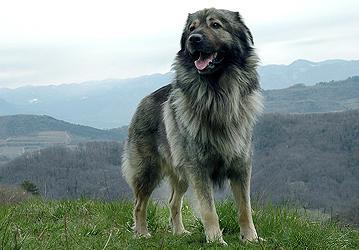 © Wikimedia.org/Svar12, CC0
© Wikimedia.org/Svar12, CC0
The Keeshond (/ˈkeɪshɒnd/ KAYSS-hond, plur. Keeshonden) is a medium-sized dog with a plush, two-layer coat of silver and black fur with a ruff and a curled tail. It originated in Holland, and its closest relatives are the German spitzes such as the Großspitz (Large Spitz), Mittelspitz (Medium Spitz), Kleinspitz (Miniature Spitz), Zwergspitz (Dwarf-Spitz) or Pomeranian. The Keeshond was previously known as the Dutch Barge Dog, as it was frequently seen on barges traveling the canals and rivers of the Netherlands. The Keeshond was the symbol of the Patriot faction in the Netherlands during political unrest in the years immediately preceding the French Revolution. (Source: Wikipedia.org, CC BY-SA)
The Kerry Beagle (Irish: An Pocadán Ciarraíoch) is the only extant scent hound breed native to Ireland. It is unclear why the name 'beagle' has been applied, as the Kerry Beagle is a medium-sized hound; height is between 56–61 cm (22–24 in), weight is up to 27 kg (60 lb), sharing little in common with the Beagle. The Kerry Beagle has a broad head, a short coat and long ears, black and tan is the more common colour but the coat may be tan and white, blue mottled and tan or black. The breed's looks suggests speed and endurance. (Source: Wikipedia.org, CC BY-SA)
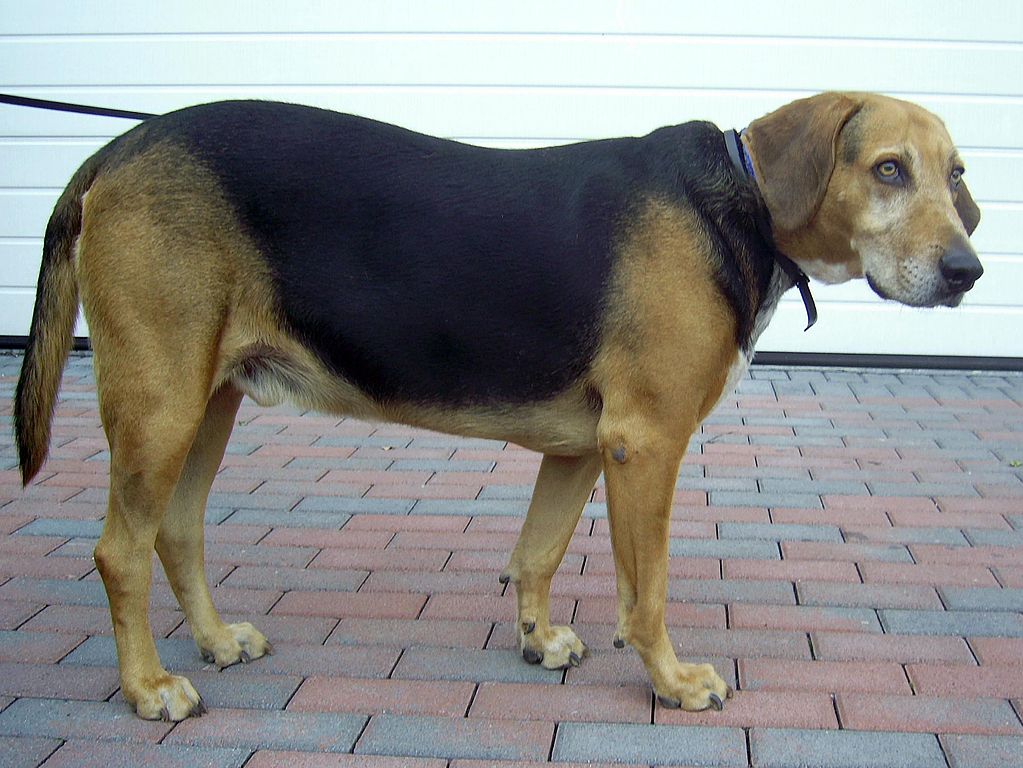 © Wikimedia.org/Martina Dominick, CC BY-SA-DE
© Wikimedia.org/Martina Dominick, CC BY-SA-DE
The Kerry Blue Terrier (also known as the Irish Blue Terrier) (Irish: An Brocaire Gorm) is a breed of dog. Originally bred to control vermin including rats, rabbits, badgers, foxes, otters and hares, over time the Kerry became a general working dog used for a variety of jobs including herding cattle and sheep, and as a guard dog. Today the Kerry has spread around the world as a companion and working dog. Despite a Kerry Blue winning Crufts (the most prestigious UK dog show) in 2000, it remains an 'unfashionable' breed, and is distinctly uncommon; however, it is not as threatened as some of the other terrier breeds such as the Skye Terrier, Sealyham Terrier, and Dandie Dinmont Terrier. (Source: Wikipedia.org, CC BY-SA)
The King Charles Spaniel (also known as the English Toy Spaniel) is a small dog breed of the spaniel type. In 1903, the Kennel Club combined four separate toy spaniel breeds under this single title. The other varieties merged into this breed were the Blenheim, Ruby and Prince Charles Spaniels, each of which contributed one of the four colours available in the breed. The King Charles has large dark eyes, a short nose, a high domed head and a line of black skin around the mouth. On average, it stands 9 to 11 inches (23 to 28 cm) at the withers, with a small but compact body. The breed has a traditionally docked tail.Except in the UK and some other European Countries where docking and cropping has been illegal since 2006.Cropping of ears has been illegal in the UK for over 100 years. It has the long pendulous ears typical of a spaniel and its coat comes in four varieties, trait it shares with its offshoot, the Cavalier King Charles Spaniel. (Source: Wikipedia.org, CC BY-SA)
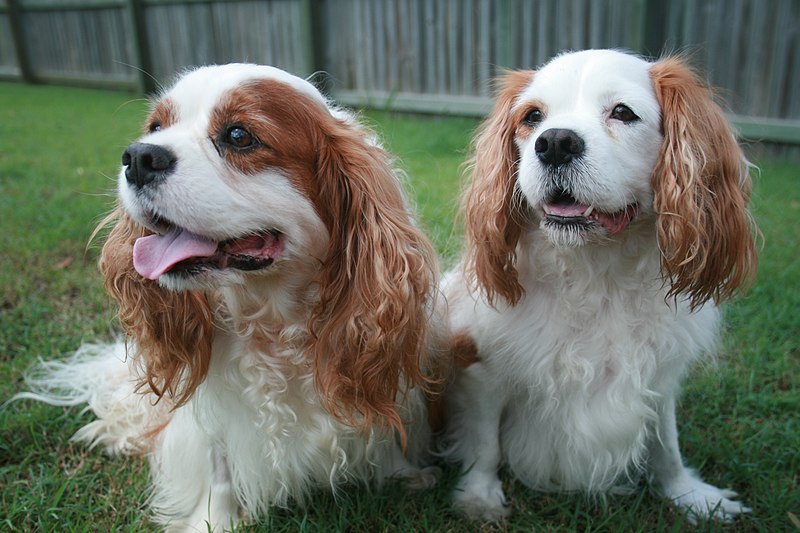 © Wikimedia.org/Kbwatts, CC BY-SA
© Wikimedia.org/Kbwatts, CC BY-SA
The Kintamani (Indonesian: anjing kintamani) or the Kintamani-Bali Dog is a dog native to the Indonesian island of Bali and originated from the Kintamani region. It is a popular pet for the Balinese and locally Bali's only official breed. The breed was developed from free-roaming local Bali street dogs and was recognised by the FCI in 2019. The Kintamani looks something like a mix between the Samoyed and a Malamute. They have long hair, a broad face, a flat forehead, and flat cheeks like Chinese dogs such as the Chow Chow and are amenable to life as a pet. Whilst many live much the same kind of life as an average village dog, they dig holes to nest their young and some live in small caves among the boulders around Kintamani. They are locally considered good-looking dogs are more often sought after as good pets. The Kintamani dog is gentle around people, yet retains enough assertive behavior to render it a noteworthy (but not vicious) watchdog. (Source: Wikipedia.org, CC BY-SA)
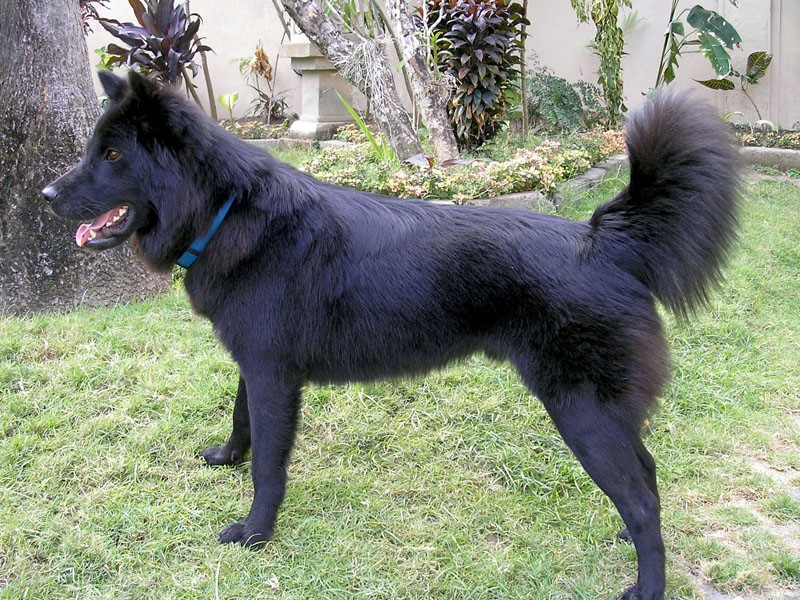 © Wikimedia.org/Imk0278, CC0
© Wikimedia.org/Imk0278, CC0
The Kishu (紀州犬, Kishū-Ken), sometimes called Kishu Inu or Kishu dog, is a Japanese breed of dog. It is descended from ancient medium-sized breeds and named after the Kishu region, now Mie Prefecture and Wakayama Prefecture. It was designated a living national monument of Japan in 1934. Kishu have been prized since prehistoric times for boar and deer hunting. Like the Shiba, they are often quiet. Kishu will stalk prey quietly rather than bark. They are the most commonly used purebred native Japanese breed used for hunting boar to this day. (Source: Wikipedia.org, CC BY-SA)
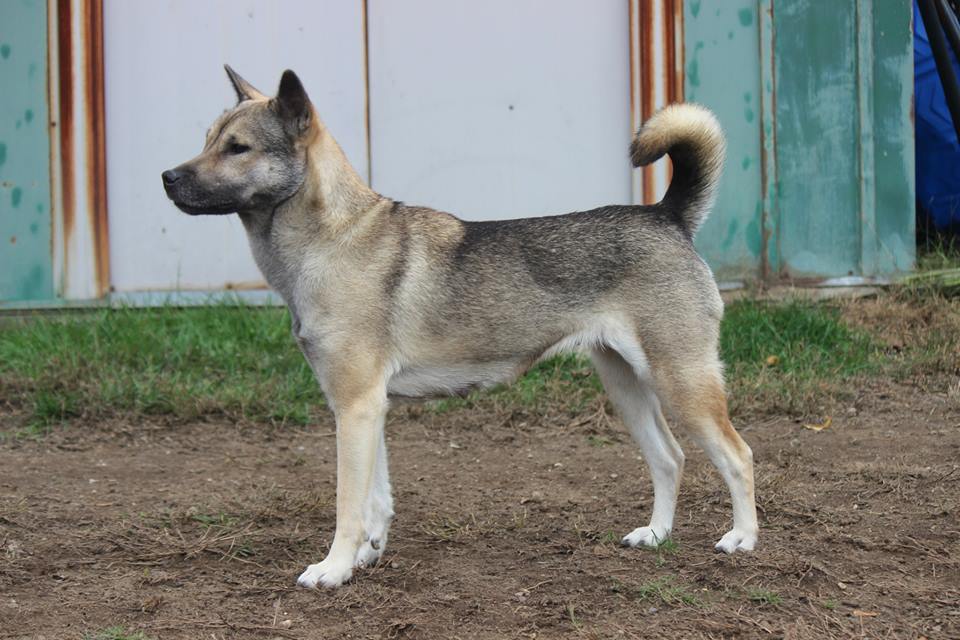 © Wikimedia.org/CJ Hammond, CC BY-SA
© Wikimedia.org/CJ Hammond, CC BY-SA
The Kokoni (Greek: Κοκόνι) is a small domestic dog breed from Greece, only recently established as a standardized breed. The foundation stock, a general landrace of small dogs of the region, are widely found throughout the country. This breed of dog is considered to be of a small to medium size, ranging from approximately 4 to 8 kilograms, and with an average height around 29 centimeters. They have dropped ears, a short snout, and a long body, with a long and curved tail. This breed comes in a variety of colors and combinations of colors. (Source: Wikipedia.org, CC BY-SA)
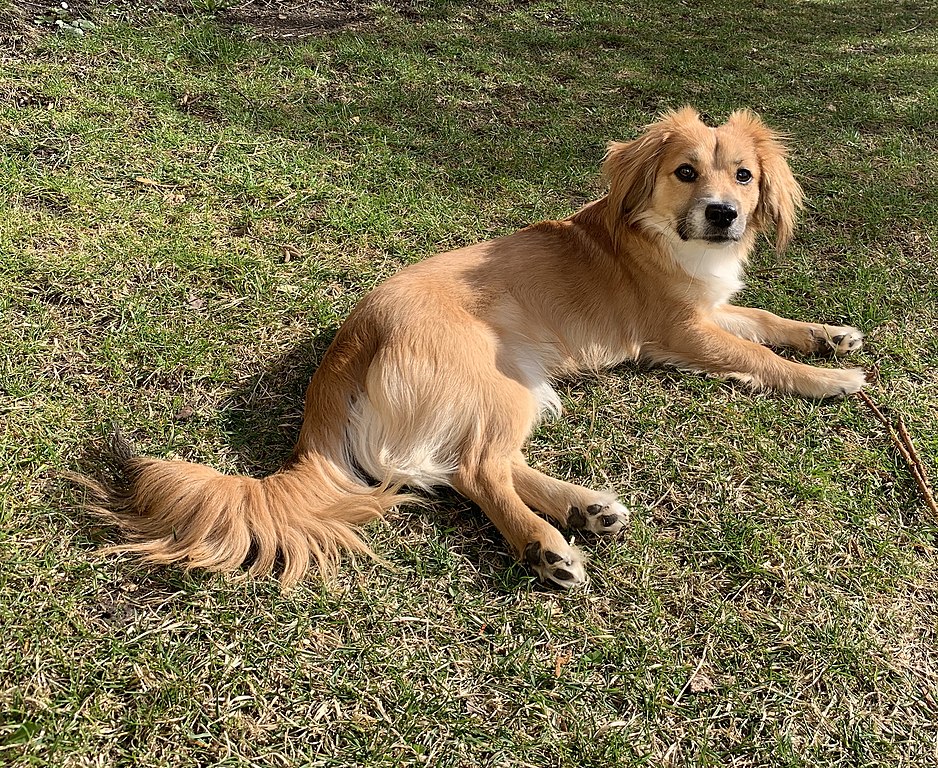 © Wikimedia.org/Hoib3rgA, CC BY-SA
© Wikimedia.org/Hoib3rgA, CC BY-SA
The Kombai or Polygar dog is a breed of working dog native to Tamil Nadu in Southern India. Traditionally kept for guarding and protection, they have a reputation for making excellent guard dogs. they were also occasionally used for hunting big games. The Kombai is described as a broad, short, muscular, powerful and athletic dog that stands around 58 centimetres (23 in). They have a short, smooth coat that is usually light brown to dark red in colour, and a black muzzle. They have dark eyes, the mid-length ears with bent tips, and a fine muzzle. The breed has a broad, slightly haired tail that is carried over their back resembling a sickle. (Source: Wikipedia.org, CC BY-SA)
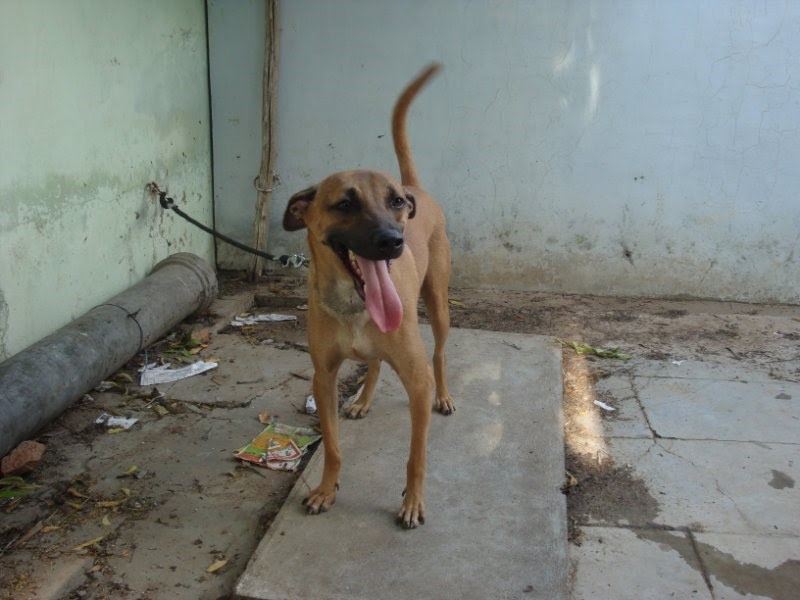 © Wikimedia.org/Richie2089, CC BY-SA
© Wikimedia.org/Richie2089, CC BY-SA
The Komondor (/ˈkɒməndɔːr, ˈkoʊm-/), also known as the Hungarian sheepdog, is a large, white-coloured Hungarian breed of livestock guardian dog with a long, corded coat. Sometimes referred to as 'mop dogs', the Komondor is a long-established dog breed commonly employed to guard livestock and other property. The Komondor was brought to Europe by the Cumans and the oldest known mention of it is in a Hungarian codex from 1544. The Komondor breed has been declared one of Hungary’s national treasures, to be preserved and protected from modification. The Komondor is a large breed of dog—many are over 30 inches (76 cm) tall—one of the larger breeds of dog. The body is covered with a heavy, matted, corded coat. They have robust bodies, strongly muscled with long legs and a short back. The tail is carried with a slight curl. The body when seen sideways, forms a prone rectangle. (Source: Wikipedia.org, CC BY-SA)
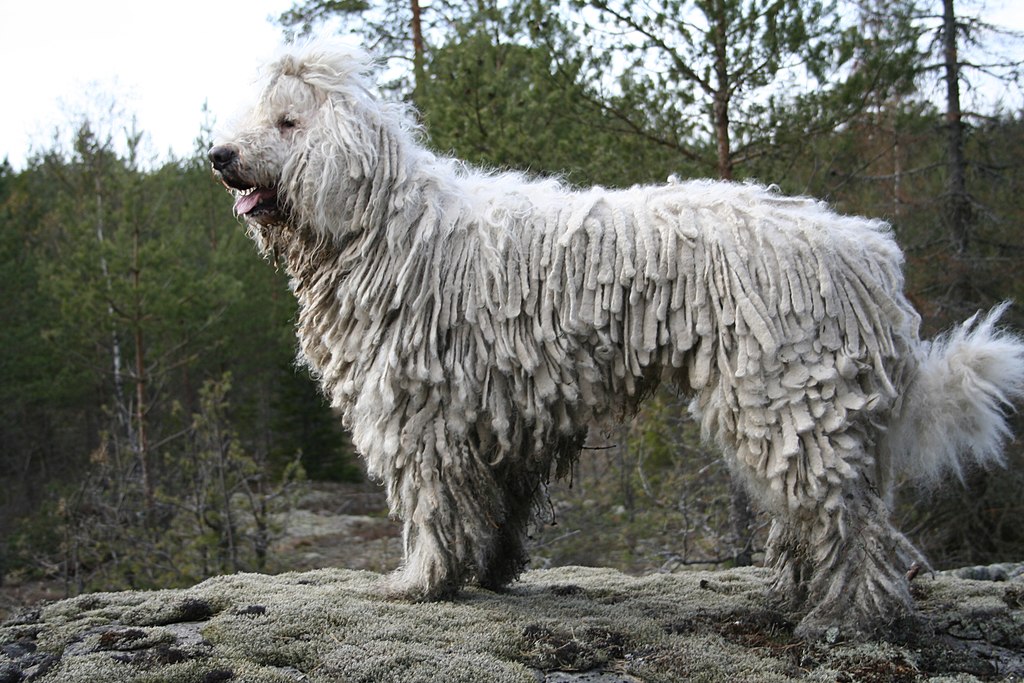 © Wikimedia.org/Kari, CC BY-SA
© Wikimedia.org/Kari, CC BY-SA
The Kooikerhondje (Dutch for 'Duck catcher's small dog') is a small spaniel-type breed of dog of Dutch ancestry that was originally used as a working dog, particularly in an eendenkooi (duck decoy) to lure ducks. Kooikers were popular in the 17th and 18th century and appear in the paintings of Rembrandt and Jan Steen. The breed is gaining popularity in the United States, Canada and Scandinavia, where it is still relatively unknown. The Kooikerhondje is a small, flashy, orange and white spaniel-like sporting dog. Originally bred in the Netherlands as a duck decoy dog, its heavily white plumed tail waves jauntily to entice and lure ducks to follow it into Eendenkooi (elaborate manmade pond trapping systems). When not working the traps, Kooikers were expected to work on the farm to catch vermin. (Source: Wikipedia.org, CC BY-SA)
The Koolie (also known as the Australian Koolie or by the historic misnomer 'German Coolie') is an Australian dog breed. The Koolie is a working or herding dog which has existed in Australia since the early 19th century when it was bred from imported British working dogs. Robert Kaleski, in an article on Cattle Dogs in the August 1903 issue of the Agricultural Gazette of New South Wales, describes the 'Welsh heeler or merle, erroneously known as the German collie,' as a 'blue-gray dog about the size and build of a smooth-haired collie, generally with wall eyes.' The British background predominated in the dogs that came to be associated with the 'German collie' name. (Source: Wikipedia.org, CC BY-SA)
 © Wikimedia.org/Tjukurpa, CC BY-SA
© Wikimedia.org/Tjukurpa, CC BY-SA
The Jindo dog (진도개, Jindo-gae, 진도견, Jindo-gyeon, 珍島犬), formerly known as Chindo dog is an indigenous dog native to Jindo Island in South Korea. It is one of South Korea's Natural Treasures (대한민국의 천연기념물/大韓民國의 天然紀念物), prized for its loyalty and homing instinct. Due to its protected status within South Korea, only dogs born on Jindo Island can be officially registered as a Jindo by the Government of South Korea after an inspection, although the Jindo dog was registered as a breed by the United Kennel Club on January 1, 1998 and by the Fédération Cynologique Internationale in 2005. Jindos are double-coated spitz-type dogs. The keen and alert appearance of the Jindo gives the impression of intelligence, strength, loyalty, and agility. Other features include forward-pointing upright ears and a double coat. (Source: Wikipedia.org, CC BY-SA)
The Kromfohrländer (/ˈkroʊmfərlændər/ KROHM-fər-land-ər) commonly known as Kromi is a breed of dog that originated in Germany. It is used as a companion dog. Particularly long lived, reaching 17-18 years old regularly. Very attached to their owners, often being described as a 'one-person dog'. The Kromfohrlander comes in 2 coat variations: rough hair (Rauhaar) and smooth hair (Glatthaar). The distinction is the presence of a beard on the rough variety and a rather long coat on the furnishings of the smooth variety. Therefore, the rough resembles a terrier, while the smooth looks rather like a spaniel. (Source: Wikipedia.org, CC BY-SA)
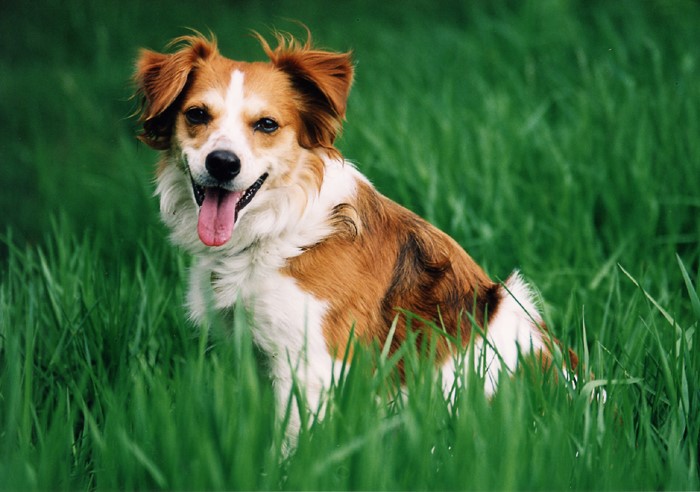 © Wikimedia.org/Elke Hartmann, CC BY-SA
© Wikimedia.org/Elke Hartmann, CC BY-SA
The Kuchi Dog, also known as the Afghan Shepherd, is an Afghan livestock guardian dog, taking its name from the Kuchi people of Afghanistan. It is a working dog following the nomads, protecting caravans and flocks of sheep, goats, camels and other livestock from wolves, big cats and thieves. The Kuchi dog breed possesses a very rich gene pool and the dogs adapt well to varying environments. It also means that gene expression can vary greatly from one individual to another. For that reason, it is often difficult for an unaccustomed observer to determine what makes a particular dog a true Kuchi dog, or what type of a Kuchi dog it is. (Source: Wikipedia.org, CC BY-SA)
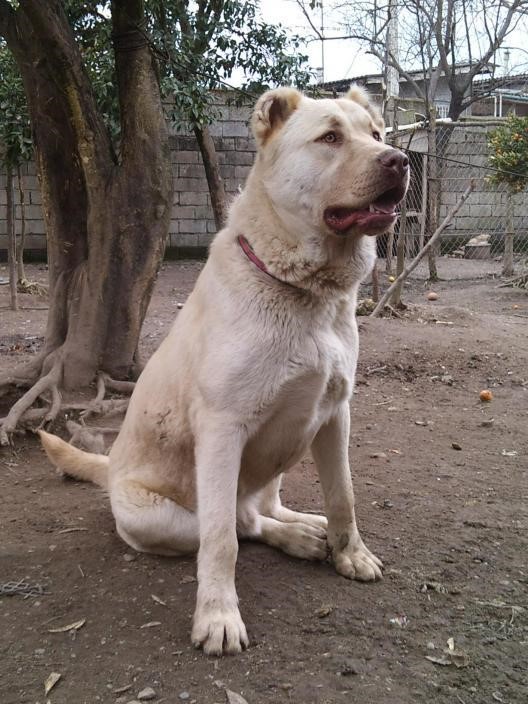 © Wikimedia.org/Sabawoon Nezami, CC BY-SA
© Wikimedia.org/Sabawoon Nezami, CC BY-SA
The Kuvasz is a traditional Hungarian breed of flock guardian dog. Mention of the breed can be found in old Hungarian texts. They have historically been royal guard dogs, or guarded livestock, but have been increasingly found in homes as pets over the last seventy years. The American Kennel Club includes the breed in the working dog group. The Kuvasz is a large and powerful dog: dogs stand some 71–76 cm at the withers, with weights in the range 48–62 kg; bitches may stand 66–70 cm and weigh 37–50 kg. The coat is white or ivory-white; it is thick and coarse, with a soft undercoat. The skin is slate-grey; the tip of the nose, the lips and the rims of the eyes are black, and the pads of the paws are black or slate-grey. (Source: Wikipedia.org, CC BY-SA)
The Labrador Retriever or simply Labrador is a British breed of retriever gun dog. It was developed in the United Kingdom from fishing dogs imported from the colony of Newfoundland (now a province of Canada), and was named after the Labrador region of that colony. It is among the most commonly kept dogs in several countries, particularly in the Western world. The Labrador is friendly, energetic, and playful. It was bred as a sporting and hunting dog but is widely kept as a companion dog. It may also be trained as a guide or assistance dog, or for rescue or therapy work. (Source: Wikipedia.org, CC BY-SA)
The Lagotto Romagnolo is an Italian breed of dog. It originates in the marshlands of the Delta del Po in the eastern part of the Romagna sub-region of Italy. The name derives from Romagnol can lagòt, meaning 'water dog'. Its traditional function was as a gun dog, specifically a water retriever; since the drainage of large areas of wetland habitat in its area of origin, it is now more often used to hunt for truffles. The Lagotto is of small to medium size, rarely over 50 cm at the withers, powerfully built and of rustic appearance. It is roughly square in outline, the body length more or less equal to the height. The coat is thick, wool-like and tightly curled into ringlets. It may be completely off-white, or off-white with orange or brown patches or roaning, or solid orange or brown either with or without white markings. (Source: Wikipedia.org, CC BY-SA)
The Lakeland Terrier is a dog breed, which takes its name from its place of origin, the Lake District in England. The dog is a small to mid-size member of the Terrier family. While independent in personality, it interacts well with owners and all family members, and is mostly hypo-allergenic (non shedding). In the United Kingdom, the Lakeland Terrier is considered a vulnerable dog breed at risk of going extinct through low levels of breeding, according to The Kennel Club. In the United States, the Lakeland Terrier ranked 148 out of 193 breeds by number of American Kennel Club puppy registrations in 2019. At 15–17 lb (7–8 kg), the Lakeland Terrier is the smallest of the long legged, black and tan terriers. It is similar in appearance to the slightly larger Welsh Terrier but is finer-boned. The largest of the threesome in this similar group of Terriers is the Airedale. The Lakeland is a sturdy dog, compact, free moving and able to cover ground with little effort and much quickness. (Source: Wikipedia.org, CC BY-SA)
The Lancashire Heeler is a small breed of dog developed for use as a drover and herder of cattle. The Lancashire Heeler is listed by the Kennel Club (UK) as an endangered breed. The coat is harsh and smooth with an undercoat which keeps the dog dry in all weathers. It may have a slight mane round the neck in winter. The dog is usually black and tan, but liver and tan is now recognised by the Kennel Club. They are slightly longer than height at withers, usually measures between 10–12 inches (25–30 cm) at the shoulder and weighs 13–18 pounds (5.9–8.2 kg). Ears can be tipped or erect. (Source: Wikipedia.org, CC BY-SA)
The Landseer is a dog that originated in Canada. It is a black and white variety of the Newfoundland that is recognised as an independent breed in continental Europe. The Landseer's black and white coloration arises from the recessive piebald color allele found in Newfoundlands, the piebald coloration is a recessive trait so a single litter can have both Landseer and solid-colored puppies, depending on the genotype of the parents. With this split in recognition gradual differences in appearance began to appear between the two forms, the European form is taller with longer legs and less bulk, and a longer more tapered head, its coat is said to be curlier whilst the Newfoundland's is said to be wavier. (Source: Wikipedia.org, CC BY-SA)
 © Wikimedia.org/Elevage des Pandas Des Terres Rouges, CC BY-SA
© Wikimedia.org/Elevage des Pandas Des Terres Rouges, CC BY-SA
The Lapponian Herder (Lapinporokoira or Lapp Reindeer Dog or Lapsk Vallhund) is a breed of dog from Finland, one of three Lapphund breeds developed from a type of dog used by the Sami people for herding and guarding their reindeer. The Lapinporokoira is a medium-sized dog, with medium length fur in a double coat. Ears are pricked (standing up; drop ears are a disqualifying fault.) Colour is generally black or dark grey or brown, and occasionally red brown, with a lighter shade on the head and lower parts of the body, often with white markings. Medium in build, height should be 51 cm (20 in) at the withers for males, 46 cm (18 in) for females. Males and females should look distinctly different. Weight is between 55–65 lb (25–29 kg), males usually heavier than females.[citation needed] (Source: Wikipedia.org, CC BY-SA)
The Large Münsterländer (or Großer Münsterländer) is a breed of gun dog originally from the Münster region in Germany. The first breed club was founded in Germany in 1919 and the breed was recognised by the Kennel Club (UK) in 1971. The breed is an offshoot of the German Longhaired Pointer, and was officially recognized as a separate breed when the German Longhaired Pointer club chose to deny recognition to the black and white color variation. The breed can also be a great family dog/pet. They are very Loyal. (Source: Wikipedia.org, CC BY-SA)
The Leonberger is a dog breed, whose name derives from the city of Leonberg in Baden-Württemberg, Germany. This breed occurs with a generous double coat; the Leonberger is a large, muscular, and elegant dog with balanced body type, medium temperament, and dramatic presence. The head is adorned with a striking black mask and projects the breed's distinct expression of intelligence, pride, and kindliness. Remaining true to their early roots as a capable family and working dog and search-and-rescue dog (particularly water), the surprisingly agile Leonberger is sound and coordinated, with both strength in bearing and elegance in movement. A sexually dimorphic breed, the Leonberger possesses either a strongly masculine or elegantly feminine form, making gender immediately discernible.: 5 (Source: Wikipedia.org, CC BY-SA)
The Lhasa Apso (/ˈlɑːsə ˈæpsoʊ/ LAH-sə AP-soh) is a non-sporting dog breed originating in Tibet. It has traditionally been used as an interior sentinel. Dogs stand about 25 cm at the withers, bitches slightly less. The coat may be black, brownish, dark grizzle, golden, honey, parti-colour, sandy, slate-coloured, smoke-coloured or white. It is thick and heavy, with a hard straight outer coat and a medium under-coat. The eyes are dark and the nose is black, and the ears are pendant. The tail is curved, sometimes with a kink at the tip, and should be carried over the back. (Source: Wikipedia.org, CC BY-SA)
The Löwchen or Little Lion Dog (German: Löwchen, 'little lion'; French: Petit chien lion, 'little lion dog') is a breed of small dog. The Löwchen once had the dubious distinction, like the Portuguese Water Dog and the Havanese, of being the rarest dog in the world. In 1973 there were only 65 registered examples of the breed. Even today, the breed generally has fewer than a few hundred new registrations each year worldwide. The Löwchen is a compact companion breed with slightly off square proportions and balanced moderate angles in the front and rear. The silhouette of the breed calls for a long mane in the front with a flat topline. The Löwchen tail should be set coming off the topline and be over the back in the shape of a tea cup handle in movement. (Source: Wikipedia.org, CC BY-SA)
 © Wikimedia.org/Jappitoo, CC BY-SA
© Wikimedia.org/Jappitoo, CC BY-SA
Mackenzie River husky describes several overlapping historical populations of Arctic and sub-Arctic sled dog originally bred to support fur traders for Hudson’s Bay Company and later prospectors during the Klondike Gold Rush. A mixture of native sled dogs and European freighting dogs, Mackenzie River huskies were prized for their ability to haul heavy loads long distances in the snow with minimal care. Since the advent of modern mechanized travel in the Arctic, moving cargo by dogsled has become nearly obsolete and only small populations of these dogs still exist. The Mackenzie River husky stands 26 to 29 inches (66 to 74 cm) in height and weighs 63 to 104 pounds (29 to 47 kg). Usually long-coated, they are rangy, deep-chested and long-legged, built for heavy freighting in single file through deep snow. Their colors are the usual northern-dog range of black and white, shades of grey and sable, tan, blond, and red. (Source: Wikipedia.org, CC BY-SA)
The Magyar agár (MA) is a dog breed. It is a type of sighthound originating in Hungary and lands that previously belonged to the Austro-Hungarian Empire (such as Transylvania). It is used for hunting and coursing, and is also kept as a companion. The Magyar agár is a sighthound of elegant yet rugged stature. While they bear some resemblance to Greyhounds, there are a number of significant differences in conformation between the two breeds. Magyar agárs are longer in body than they are tall, and have a heavier bone structure than Greyhounds. Their heads are more wedge-shaped, with substantial jaw muscles and shorter snouts, giving them a less refined appearance than most Greyhounds. (Source: Wikipedia.org, CC BY-SA)
 © Wikimedia.org/Hachieko, CC BY-SA
© Wikimedia.org/Hachieko, CC BY-SA
The Majorca Shepherd Dog (Catalan: Ca de bestiar, Spanish: Perro de pastor mallorquín) is a domesticated breed of dog, used in the Balearic Islands of Spain, both for guarding and herding sheep and as a general purpose farm dog. It is a medium-sized dog with black fur or black with white markings on its chest. It comes in both shorthaired and longhaired varieties. The Majorca Shepherd Dog is a tall, up to 73 cm and up to 40 kg (88 lb) shepherd and guard dog. Most of the breed is short-haired, about 1.5 to 3 cm long on the back, with a very fine, thin undercoat. In the long haired variety, the hair is slightly wavy on the back and can reach over 7 cm in length in the winter. In the long-haired variety the undercoat is well distributed and not thick, showing varying shades of black. The ears, which are slightly bent from the side, are relatively small, triangular, thick and set high on the head. (Source: Wikipedia.org, CC BY-SA)
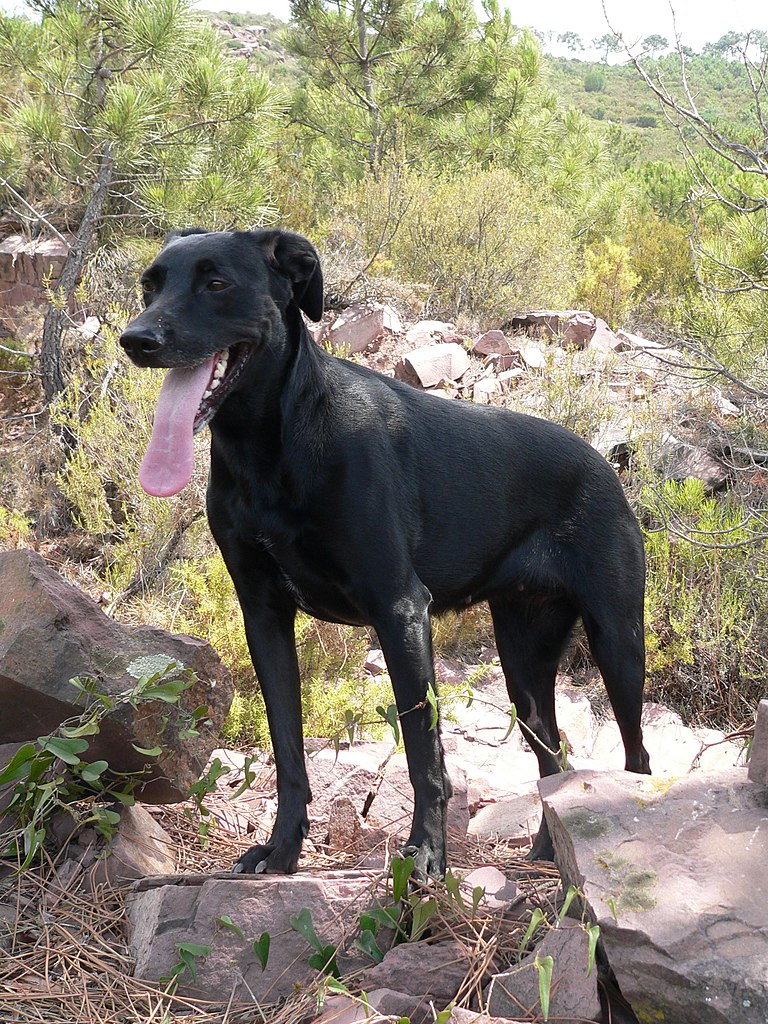 © Wikimedia.org/Kriegerkalle, CC0
© Wikimedia.org/Kriegerkalle, CC0
Maltese dog refers both to an ancient variety of dwarf canine generally associated with the island of Malta and to a modern breed of dog in the toy group. The contemporary variety is genetically related to the Bichon, Bolognese, and Havanese breeds. The precise link, if any, between the modern and ancient species is not known. Nicholas Cutillo suggested that Maltese dogs might descend from spitz-type canines, and that the ancient variety probably was similar to the latter Pomeranian breeds with their short snout, pricked ears, and bulbous heads. These two varieties, according to Stanley Coren, were perhaps the first dogs employed as human companions. The modern variety traditionally has a silky, pure-white coat, hanging ears and a tail that curves over its back, and weighs up to 3–4 kg (7–9 lb). The Maltese does not shed. The Maltese is kept for companionship, for ornament, or for competitive exhibition. (Source: Wikipedia.org, CC BY-SA)
The Manchester Terrier is a breed of dog of the smooth-haired terrier type. It was first bred in the 19th century to control vermin, notably rats, at which it excelled. So efficient at the task was it that it often appeared in rat-baiting pits until that sport, which had effectively been illegal in the UK since 1835, finally died out at the beginning of the 20th century. The breed is generally healthy, although dogs can be affected by several inheritable genetic disorders. A crash in the number of registered Manchester Terriers following the Second World War has resulted in the Kennel Club categorising it as a vulnerable native breed, in danger of extinction. (Source: Wikipedia.org, CC BY-SA)
The Maneto is a dog breed native to Andalusia in Spain. It is derived from the medium-sized Andalusian Hound, and is used to hunt rabbits, partridge, quail, and for retrieving ducks from the water. Its legs are short relative to its body, and its ears are triangular and blunt. The breed is recognised by the name Maneto by the Real Sociedad Canina de España. The word 'maneto' in Spanish indicates an impediment or defect in any of the hands or legs. (Source: Wikipedia.org, CC BY-SA)
The Maremmano-Abruzzese Sheepdog, (Italian: Cane da pastore Maremmano-Abruzzese), also called Maremmano, the Maremma Sheepdog or Abruzzese Sheepdog, and Cane da Pastore Abruzzese or Pastore Abruzzese (Abruzzese Sheepdog and Abruzzese Shepherd, respectively) is an Italian breed of livestock guardian dog. It is frequently described as a “gentle giant” due to its large size and passive and gentle nature (and also due to its Abruzzese origin, as residents of Abruzzo are known stereotypically as “strong but kind”, a descriptor utilized by Primo Levi). (Source: Wikipedia.org, CC BY-SA)
The McNab Dog, also called the McNab Shepherd or McNab Collie is a herding dog that originated in Hopland, Mendocino County, Northern California. The McNab was bred to withstand the tough conditions found in California such as heat, burrs, foxtails, and rugged terrain. Until recently, the McNab was little known outside California, but in last three decades have seen a gain in popularity and geographic dispersal of the breed. The appearance of the McNab can vary considerably. The dog is medium-sized with females standing 16–21 inches at the shoulder and weighing 30–50 pounds and males standing 18–25 inches at the shoulder and weighing 35–65 pounds. The dogs have a variety of ear sets from pricked ears to floppy ears and everything in between. Tails are either short (bobbed naturally or mechanically) or long. McNabs come in colors of black, red, blonde, blue, lilac and sable with variations of solid, added white or added white and tan (tri colored). (Source: Wikipedia.org, CC BY-SA)
 © Wikimedia.org/Randifredricks, CC BY-SA
© Wikimedia.org/Randifredricks, CC BY-SA
The Miniature American Shepherd, frequently abbreviated MAS, is a small herding dog breed. The MAS is highly intelligent and biddable. The breed is often trained for dog sports such as herding, agility, obedience, canine freestyle, flyball, and others. The Miniature American Shepherd was recognised by the American Kennel Club (AKC) in 2015 and is the club's 186th breed. In September 2019, the Fédération Cynologique Internationale (FCI) officially accepted the breed. The Miniature American Shepherd is a small dog, with the breed standard specifying a height of 14-18 inches (36–46 cm) for males and 13-17 inches (33–43 cm) for females. The topline is level from withers to hip joint. The tail may be undocked, a natural bobtail, or may be docked to a length not exceeding three inches. (Source: Wikipedia.org, CC BY-SA)
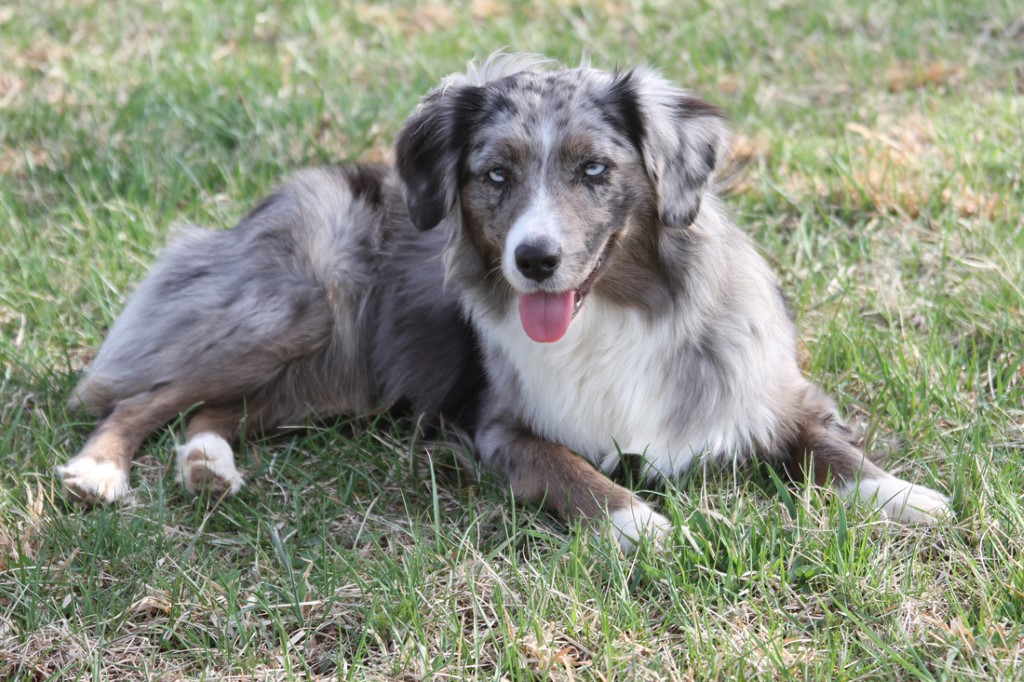 © Wikimedia.org/Lextergrace, CC BY-SA
© Wikimedia.org/Lextergrace, CC BY-SA
The English Miniature Bull Terrier is a breed with origins in the extinct English White Terrier, the Dalmatian and the Bulldog. The first existence is documented 1872 in The Dogs of British Island. Miniature Bull Terriers have short, fine, and glossy coats that are very close to the skin, like Bull Terriers. They are accepted in the ring to be white, white with another colour, or fully coloured. However, like the Bull Terriers, any blue or liver-coloured coats are undesirable. These dogs require minimal grooming. (Source: Wikipedia.org, CC BY-SA)
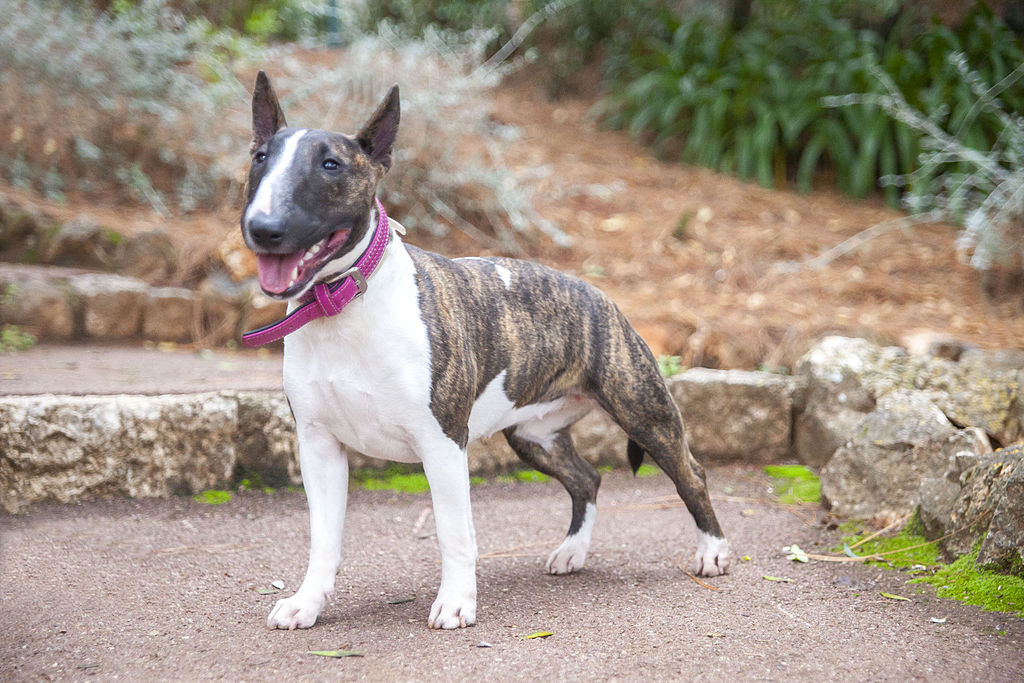 © Wikimedia.org/Darmaninjl, CC BY-SA
© Wikimedia.org/Darmaninjl, CC BY-SA
The Miniature Fox Terrier is a small, fine, lightweight working terrier developed as a hunting dog and vermin router. It is known colloquially in its native Australia as the “Mini Foxie”. A balanced, smoothly-muscled dog breed, the Miniature Fox Terrier has a small sized, distinctive head with erectile ears that can stand straight up or fold at the tips. Another distinguishing feature is its articulate, oval-shaped foot - a feature found in very few small breeds of dog. The breed standard has always allowed for the dog's tail to be docked or undocked, however owners need to be aware of and obey local laws in this regard. Natural bobtails are known to occur. There are only three permitted colour combinations: black & white, tan & white, and black, tan & white. The coat of the Miniature Fox Terrier is always short and fine. Weight is 3.5 to 5.5 kilograms (8 to 12 lbs) and height at the withers is 9.5 to 12.0 inches (24 cm to 30.5 cm). (Source: Wikipedia.org, CC BY-SA)
The Miniature Pinscher, also known as the Zwergpinscher, and Min Pin, is a small breed of dog of the pinscher type originating in Germany. The breed's earliest ancestors may have included the German Pinscher mixed with Italian greyhounds and dachshunds. The Miniature Pinscher is structurally a well balanced, sturdy, compact, short-coupled, smooth-coated dog. They are naturally well groomed, vigorous and alert. Characteristic traits are their hackney-like action, fearless animation, complete self-possession, and spirited presence. Legs should be straight with no bending in or out. They are also known to have separation anxiety. The Miniature Pinscher frequently has a docked tail and cropped ears, though the AKC no longer requires ear cropping for shows. They can also sometimes have natural erect ears. (Source: Wikipedia.org, CC BY-SA)
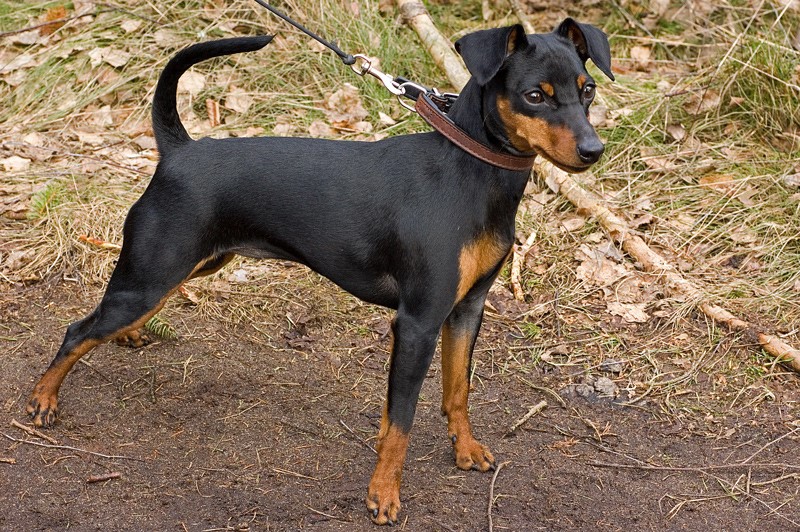 © Wikimedia.org/Sebastian Wallin, CC BY
© Wikimedia.org/Sebastian Wallin, CC BY
The Miniature Schnauzer is a breed of small dog of the Schnauzer type that originated in Germany in the mid-to-late 19th century. Miniature Schnauzers may have been developed from the smallest specimens of the Standard Schnauzer, or crosses between the standard and one or more smaller breeds such as the Affenpinscher, Miniature Pinscher, and Poodles, as farmers bred a small dog that was an efficient ratting dog. They are described as 'spunky' but aloof dogs, with good guarding tendencies without some guard dogs' predisposition to bite. Miniature Schnauzers are recognized in four colors internationally: solid black, black and silver, salt and pepper, and white. It is the most popular Schnauzer breed, and remains one of the most popular worldwide, primarily for its temperament and relatively small size. As of 2020 it is the 19th most popular breed in the U.S. (Source: Wikipedia.org, CC BY-SA)
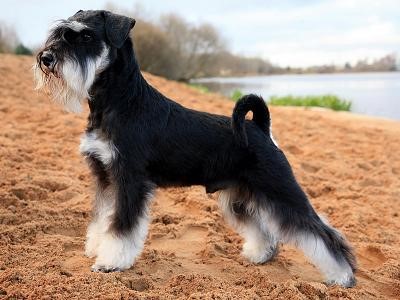 © Wikimedia.org/Zorik07, CC BY-SA
© Wikimedia.org/Zorik07, CC BY-SA

Time for recess! Post a comment, ask a question or write a review. Feel free to let us know what you think!
Heeft opzich wel goede oefeningen maar zou aanraden om ook op andere websites (gratis) te oefenen om een goed examen af te leggen
Ik heb 15 keer 50/50 gehaald op deze site ik ga naar het examencentrum en haal een 39
bij oefenexamen 1 zegt dat ik de gevarendriehoek op 50m moet plaatsen en bij 2 op 100m??
Vwb borden verkeersplein en rotonde slaat U hier de plank behoorlijk mis. Mag wel eens aangepast worden. Jammer.
Het zou handig zijn als jullie het op tyd laten gaan zoals op het examen. Groetjes David
ABS Nedir Nasıl Çalışır ? - https://www.diskfren.com/abs-nedir-nasil-calisir.html
Driving whit a tractor possible? What are the requirements? Can i drive whit a dutch T-licence?
het proefexamen op deze website is niet gedetailleerd genoeg waardoor de kennis volgens mij niet voldoende getest wordt, ik heb op meer dan 5 websites een proefexamen gemaakt en deze is zeer slecht. Gebruik aub de gratis website die de overheid heeft voorzien https://www.mijnrijbewijsb.be/, je zal zien dat de examens hier in ieder geval op deze website in veel groter detail gaan. (ik heb hier niets gekocht, enkel het gratis proefexamen gedaan)
Hallo,ik ben op de autokeuring geweigerd geweest omdat mijn rechter achtermistlicht gebroken is. Daar dit onderdeel tijdelijk onbeschikbaar is,heb ik dit hersteld met kleefband.De mistlichten werken nu allebij en ze hebben de goede rode kleur en toch ben ik opnieuw gewijgerd.hadden zij het recht mij hiervoor opnieuw te wijgeren?Zoja op welke basis? Dank u bij voorbaat.
Is de GPS verplicht in Antwerpen voor een examen praktische te gaan laten officiële doen categorie B bedankt
is er iemand die zijn examen al heeft gedaan en kan confirmeren dat dit hoe de test is
Amaai, wat moet dit moeilijk zijn voor een 17 jarige! Wel zeer leerzaam. Bedankt!